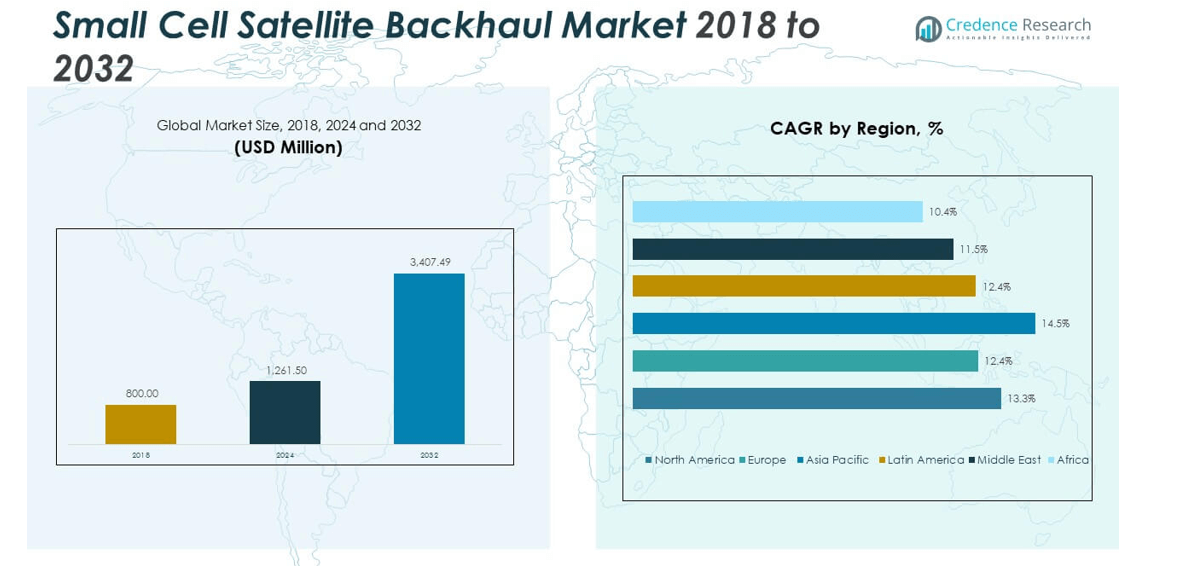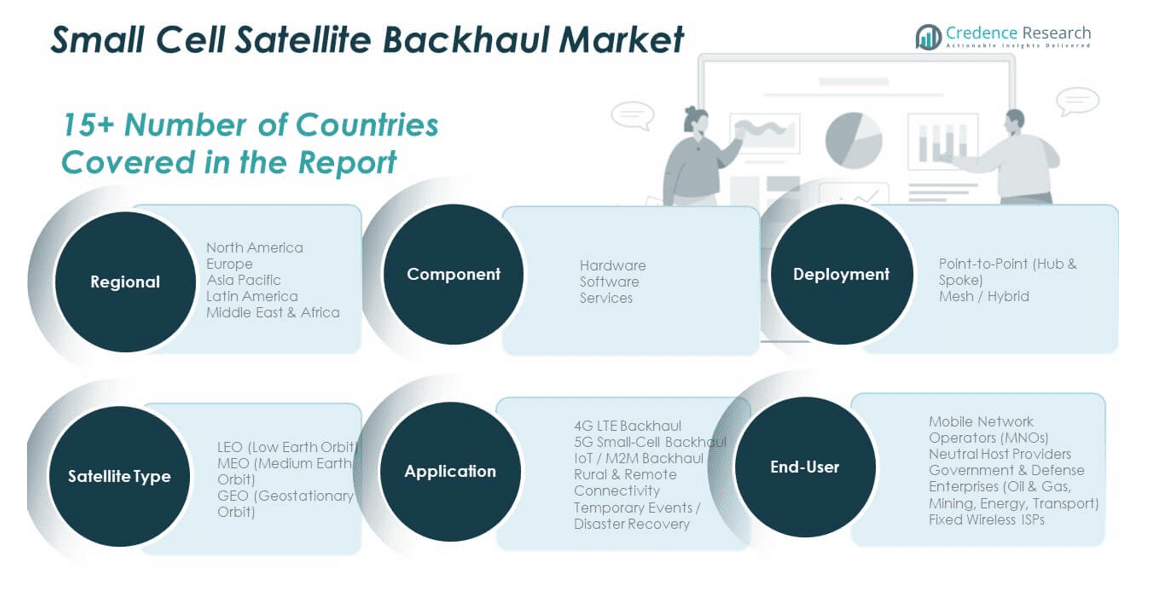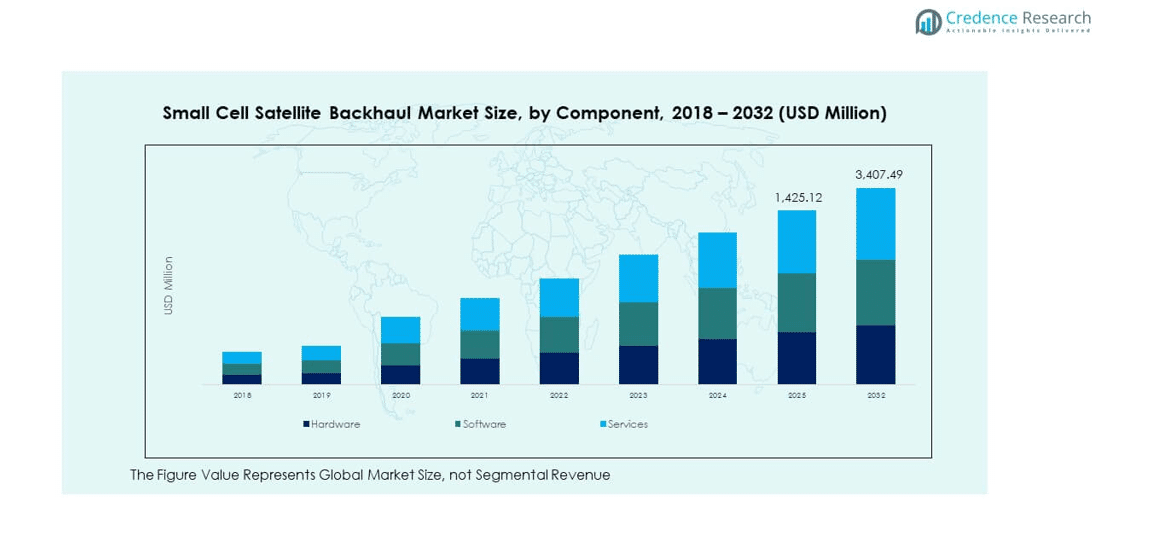CHAPTER NO. 1 : GENESIS OF THE MARKET
1.1 Market Prelude – Introduction & Scope
1.2 The Big Picture – Objectives & Vision
1.3 Strategic Edge – Unique Value Proposition
1.4 Stakeholder Compass – Key Beneficiaries
CHAPTER NO. 2 : EXECUTIVE LENS
2.1 Pulse of the Industry – Market Snapshot
2.2 Growth Arc – Revenue Projections (USD Million)
2.3. Premium Insights – Based on Primary Interviews
CHAPTER NO. 3 : SMALL CELL SATELLITE BACKHAUL MARKET FORCES & INDUSTRY PULSE
3.1 Foundations of Change – Market Overview
3.2 Catalysts of Expansion – Key Market Drivers
3.2.1 Momentum Boosters – Growth Triggers
3.2.2 Innovation Fuel – Disruptive Technologies
3.3 Headwinds & Crosswinds – Market Restraints
3.3.1 Regulatory Tides – Compliance Challenges
3.3.2 Economic Frictions – Inflationary Pressures
3.4 Untapped Horizons – Growth Potential & Opportunities
3.5 Strategic Navigation – Industry Frameworks
3.5.1 Market Equilibrium – Porter’s Five Forces
3.5.2 Ecosystem Dynamics – Value Chain Analysis
3.5.3 Macro Forces – PESTEL Breakdown
3.6 Price Trend Analysis
3.6.1 Regional Price Trend
3.6.2 Price Trend by product
CHAPTER NO. 4 : KEY INVESTMENT EPICENTER
4.1 Regional Goldmines – High-Growth Geographies
4.2 Product Frontiers – Lucrative Product Categories
4.3 Application Sweet Spots – Emerging Demand Segments
CHAPTER NO. 5: REVENUE TRAJECTORY & WEALTH MAPPING
5.1 Momentum Metrics – Forecast & Growth Curves
5.2 Regional Revenue Footprint – Market Share Insights
5.3 Segmental Wealth Flow – Component & Application Revenue
CHAPTER NO. 6 : TRADE & COMMERCE ANALYSIS
6.1. Import Analysis by Region
6.1.1. Global Small Cell Satellite Backhaul Market Import Revenue By Region
6.2. Export Analysis by Region
6.2.1. Global Small Cell Satellite Backhaul Market Export Revenue By Region
CHAPTER NO. 7 : COMPETITION ANALYSIS
7.1. Company Market Share Analysis
7.1.1. Global Small Cell Satellite Backhaul Market: Company Market Share
7.2. Global Small Cell Satellite Backhaul Market Company Revenue Market Share
7.3. Strategic Developments
7.3.1. Acquisitions & Mergers
7.3.2. New Product Launch
7.3.3. Regional Expansion
7.4. Competitive Dashboard
7.5. Company Assessment Metrics, 2024
CHAPTER NO. 8 : SMALL CELL SATELLITE BACKHAUL MARKET – BY COMPONENT SEGMENT ANALYSIS
8.1. Small Cell Satellite Backhaul Market Overview by Component Segment
8.1.1. Small Cell Satellite Backhaul Market Revenue Share By Component
8.2. Hardware
8.3. Software
8.4. Services
CHAPTER NO. 9 : SMALL CELL SATELLITE BACKHAUL MARKET – BY APPLICATION SEGMENT ANALYSIS
9.1. Small Cell Satellite Backhaul Market Overview by Application Segment
9.1.1. Small Cell Satellite Backhaul Market Revenue Share By Application
9.2. 4G LTE Backhaul
9.3. 5G Small-Cell Backhaul
9.4. IoT / M2M Backhaul
9.5. Rural & Remote Connectivity
9.6. Temporary Events / Disaster Recovery
CHAPTER NO. 10 : SMALL CELL SATELLITE BACKHAUL MARKET – BY END-USER SEGMENT ANALYSIS
10.1. Small Cell Satellite Backhaul Market Overview by End-user Segment
10.1.1. Small Cell Satellite Backhaul Market Revenue Share By End-user
10.2. Mobile Network Operators (MNOs)
10.3. Neutral Host Providers
10.4. Government & Defense
10.5. Enterprises (Oil & Gas, Mining, Energy, Transport)
10.6. Fixed Wireless ISPs
CHAPTER NO. 11 : SMALL CELL SATELLITE BACKHAUL MARKET – BY DEPLOYMENT SEGMENT ANALYSIS
11.1. Small Cell Satellite Backhaul Market Overview by Deployment Segment
11.1.1. Small Cell Satellite Backhaul Market Revenue Share By Deployment
11.2. Point-to-Point (Hub & Spoke)
11.3. Mesh / Hybrid
CHAPTER NO. 12 : SMALL CELL SATELLITE BACKHAUL MARKET – BY SATELLITE TYPE SEGMENT ANALYSIS
12.1. Small Cell Satellite Backhaul Market Overview by Satellite Type Segment
12.1.1. Small Cell Satellite Backhaul Market Revenue Share By Satellite Type
12.2. LEO (Low Earth Orbit)
12.3. MEO (Medium Earth Orbit)
12.4. GEO (Geostationary Orbit)
CHAPTER NO. 13 : SMALL CELL SATELLITE BACKHAUL MARKET – REGIONAL ANALYSIS
13.1. Small Cell Satellite Backhaul Market Overview by Region Segment
13.1.1. Global Small Cell Satellite Backhaul Market Revenue Share By Region
13.1.2. Regions
13.1.3. Global Small Cell Satellite Backhaul Market Revenue By Region
13.1.4. Component
13.1.5. Global Small Cell Satellite Backhaul Market Revenue By Component
13.1.6. Application
13.1.7. Global Small Cell Satellite Backhaul Market Revenue By Application
13.1.8. End-user
13.1.9. Global Small Cell Satellite Backhaul Market Revenue By End-user
13.1.10. Deployment
13.1.12. Global Small Cell Satellite Backhaul Market Revenue By Deployment
13.1.13. Satellite Type
13.1.14. Global Small Cell Satellite Backhaul Market Revenue By Satellite Type
CHAPTER NO. 14 : NORTH AMERICA SMALL CELL SATELLITE BACKHAUL MARKET – COUNTRY ANALYSIS
14.1. North America Small Cell Satellite Backhaul Market Overview by Country Segmen
14.1.1. North America Small Cell Satellite Backhaul Market Revenue Share By Region
14.2. North America
14.2.1. North America Small Cell Satellite Backhaul Market Revenue By Country
14.2.2. Component
14.2.3. North America Small Cell Satellite Backhaul Market Revenue By Component
14.2.4. Application
14.2.5. North America Small Cell Satellite Backhaul Market Revenue By Application
14.2.6. End-user
14.2.7. North America Small Cell Satellite Backhaul Market Revenue By End-user
14.2.8. Deployment
14.2.9. North America Small Cell Satellite Backhaul Market Revenue By Deployment
14.2.10. Satellite Type
14.2.11. North America Small Cell Satellite Backhaul Market Revenue By Satellite Type
14.3. U.S.
14.4. Canada
14.5. Mexico
CHAPTER NO. 15 : EUROPE SMALL CELL SATELLITE BACKHAUL MARKET – COUNTRY ANALYSIS
15.1. Europe Small Cell Satellite Backhaul Market Overview by Country Segment
15.1.1. Europe Small Cell Satellite Backhaul Market Revenue Share By Region
15.2. Europe
15.2.1. Europe Small Cell Satellite Backhaul Market Revenue By Country
15.2.2. Component
15.2.3. Europe Small Cell Satellite Backhaul Market Revenue By Component
15.2.4. Application
15.2.5. Europe Small Cell Satellite Backhaul Market Revenue By Application
15.2.6. End-user
15.2.7. Europe Small Cell Satellite Backhaul Market Revenue By End-user
15.2.8. Deployment
15.2.9. Europe Small Cell Satellite Backhaul Market Revenue By Deployment
15.2.10. Satellite Type
15.2.11. Europe Small Cell Satellite Backhaul Market Revenue By Satellite Type
15.3. UK
15.4. France
15.5. Germany
15.6. Italy
15.7. Spain
15.8. Russia
15.9. Rest of Europe
CHAPTER NO. 16 : ASIA PACIFIC SMALL CELL SATELLITE BACKHAUL MARKET – COUNTRY ANALYSIS
16.1. Asia Pacific Small Cell Satellite Backhaul Market Overview by Country Segment
16.1.1. Asia Pacific Small Cell Satellite Backhaul Market Revenue Share By Region
16.2. Asia Pacific
16.2.1. Asia Pacific Small Cell Satellite Backhaul Market Revenue By Country
16.2.2. Component
16.2.3. Asia Pacific Small Cell Satellite Backhaul Market Revenue By Component
16.2.4. Application
16.2.5. Asia Pacific Small Cell Satellite Backhaul Market Revenue By Application
16.2.6. End-user
16.2.7. Asia Pacific Small Cell Satellite Backhaul Market Revenue By End-user
16.2.8. Deployment
16.2.9. Asia Pacific Small Cell Satellite Backhaul Market Revenue By Deployment
16.2.10. Satellite Type
16.2.11. Asia Pacific Small Cell Satellite Backhaul Market Revenue By Satellite Type
16.3. China
16.4. Japan
16.5. South Korea
16.6. India
16.7. Australia
16.8. Southeast Asia
16.9. Rest of Asia Pacific
CHAPTER NO. 17 : LATIN AMERICA SMALL CELL SATELLITE BACKHAUL MARKET – COUNTRY ANALYSIS
17.1. Latin America Small Cell Satellite Backhaul Market Overview by Country Segment
17.1.1. Latin America Small Cell Satellite Backhaul Market Revenue Share By Region
17.2. Latin America
17.2.1. Latin America Small Cell Satellite Backhaul Market Revenue By Country
17.2.2. Component
17.2.3. Latin America Small Cell Satellite Backhaul Market Revenue By Component
17.2.4. Application
17.2.5. Latin America Small Cell Satellite Backhaul Market Revenue By Application
17.2.6. End-user
17.2.7. Latin America Small Cell Satellite Backhaul Market Revenue By End-user
17.2.8. Deployment
17.2.9. Latin America Small Cell Satellite Backhaul Market Revenue By Deployment
17.2.10. Satellite Type
17.2.11. Latin America Small Cell Satellite Backhaul Market Revenue By Satellite Type
17.3. Brazil
17.4. Argentina
17.5. Rest of Latin America
CHAPTER NO. 18 : MIDDLE EAST SMALL CELL SATELLITE BACKHAUL MARKET – COUNTRY ANALYSIS
18.1. Middle East Small Cell Satellite Backhaul Market Overview by Country Segment
18.1.1. Middle East Small Cell Satellite Backhaul Market Revenue Share By Region
18.2. Middle East
18.2.1. Middle East Small Cell Satellite Backhaul Market Revenue By Country
18.2.2. Component
18.2.3. Middle East Small Cell Satellite Backhaul Market Revenue By Component
18.2.4. Application
18.2.5. Middle East Small Cell Satellite Backhaul Market Revenue By Application
18.2.6. End-user
18.2.7. Middle East Small Cell Satellite Backhaul Market Revenue By End-user
18.2.8. Deployment
18.2.9. Middle East Small Cell Satellite Backhaul Market Revenue By Deployment
18.2.10. Satellite Type
18.2.11. Middle East Small Cell Satellite Backhaul Market Revenue By Satellite Type
18.3. GCC Countries
18.4. Israel
18.5. Turkey
18.6. Rest of Middle East
CHAPTER NO. 19 : AFRICA SMALL CELL SATELLITE BACKHAUL MARKET – COUNTRY ANALYSIS
19.1. Africa Small Cell Satellite Backhaul Market Overview by Country Segment
19.1.1. Africa Small Cell Satellite Backhaul Market Revenue Share By Region
19.2. Africa
19.2.1. Africa Small Cell Satellite Backhaul Market Revenue By Country
19.2.2. Component
19.2.3. Africa Small Cell Satellite Backhaul Market Revenue By Component
19.2.4. Application
19.2.5. Africa Small Cell Satellite Backhaul Market Revenue By Application
19.2.6. End-user
19.2.7. Africa Small Cell Satellite Backhaul Market Revenue By End-user
19.2.8. Deployment
19.2.9. Africa Small Cell Satellite Backhaul Market Revenue By Deployment
19.2.10. Satellite Type
19.2.11. Africa Small Cell Satellite Backhaul Market Revenue By Satellite Type
19.3. South Africa
19.4. Egypt
19.5. Rest of Africa
CHAPTER NO. 20 : COMPANY PROFILES
20.1. SpaceX (Starlink)
20.1.1. Company Overview
20.1.2. Product Portfolio
20.1.3. Financial Overview
20.1.4. Recent Developments
20.1.5. Growth Strategy
20.1.6. SWOT Analysis
20.2. Eutelsat OneWeb
20.3. Viasat (including Inmarsat)
20.4. SES S.A.
20.5. Intelsat
20.6. Telesat
20.7. Iridium Communications
20.8. Globalstar
20.9. AST SpaceMobile
20.10. Gilat Satellite Networks
20.11. Hughes Network Systems (EchoStar)
20.12. Comtech Telecommunications
20.13. Ceragon Networks
20.14. Ericsson
20.15. CommScope










